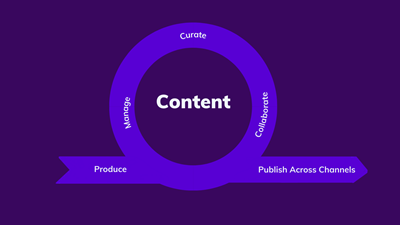How Content Marketing Teams Can Benefit From Going Agile


Today, almost every marketing team uses content to reach their goals. They have been churning out content at a breakneck speed and only plan to create more. With so much content already out there, the challenge is to give readers something of true value.
People's needs change. They scroll fast, and their choices evolve. We need a strategy that changes with them to produce content that delivers real results.
Here's where agile content marketing comes in.
Agile, as a methodology, is explicitly designed to proactively and continuously adapt to dynamic conditions. It has become a dominant management framework for marketing, with 51% of marketing teams using one or more agile practices.
The reason for this is that agile teams enjoy a lot of benefits: enhanced adaptability, improved productivity, and more. In this article, we’ll discuss how content marketing teams can benefit from going agile.
What Does It Mean For Content Marketing Teams To Be Agile?
An agile content system is a set of specialized practices that allows companies to produce a large amount of content relatively quickly.
The logic is simple.
No one knows what content will be best received. So instead of spending weeks developing one piece of great content, push out multiple pieces quickly. It can be blogs, newsletters, whitepapers, infographics, videos, or anything.
The key is to create more and test regularly. If it’s not working, adjust fast. This way, the content can remain abundant, relevant, and adaptable.
The idea was adopted from agile software development, where teams iterate continuously to develop solutions. And these solutions evolve rapidly to adjust to changes in user behaviour.
Let’s look at a few attributes of agile content marketing.
- Sprints. These are short work cycles (2-4 weeks) in which teams need to complete a project or a phase of the project.
- Cross-functional teams. Agile content marketing teams don’t work in silos. Content writers, the SEO team, PR, outreach, design, etc., all come together to plan the projects in a sprint backlog. This is a list of tasks that needs to be completed and their due dates.
- Collaboration. Teams collaborate at each phase of the process—from learning, planning, progress, and review to completion.
- Scrum. Teams have daily scrum meetings. Here, they discuss what they did yesterday, what didn't go well, what to improve, and the plan for today.
- Kanban. Teams create Kanban boards to visualize the different stages of content creation. Then as they complete each stage, the tasks are moved from one board to another.
- Test and optimize. Agile teams take a data-driven approach to creating content. They test different versions, check which ones are successful, and adjust the content based on performance.
Now agile teams have the flexibility to customize the classical agile approach. For example, Deloitte used its version of agile in marketing.
Instead of holding in-person scrums, teams met via Skype. Designers advise on email strategy; marketers pitched in on design decisions. And all this collaboration had a tremendous impact on business and culture.
In the following section, we’ll examine how content marketing teams can benefit from agile.
How Can Agile Help Content Marketing Teams?
Simply put, agile helps teams work better. Reports say that agile marketing teams are much more likely to be successful. In fact, a 2020 Mckinsey report iterates that marketing organizations have experienced revenue growth of 20-40% after shifting to agile marketing.
Benefits of content marketing teams going agile:
Higher efficiency
The agile method of content creation results in better outcomes with minimal effort. Since there is more transparency within the team, issues are raised quickly. Teams go ahead to solve them almost immediately.
For example, if a project seems stuck with a particular team member in a Kanban board, the team reaches out to solve the bottleneck.
At the end of the day, the focus is on results rather than the effort put in. Thus, agile can result in highly efficient teams.
A case in point is the story of Northern Arizona University. The four-person marketing team produced 400% more content a year after they went agile.
Increased productivity
Agile simplifies the content creation process and maximizes productivity. Frameworks like scrum and Kanban keep the process organized and aligned with the set goal. As a result, teams become more focused and, ultimately, more productive.
Also, since it provides immediate data, teams can quickly adjust and iterate on the content produced.
Moreover, when teams produce content that works well with the audience, it boosts their confidence. And a motivated team is a productive team.
More innovation
The iterative and experimentative approach of agile creates room for much innovation.
Say, a piece of content starts to work. It’s bringing in traffic, and people are engaging with it. But it can’t be guaranteed that the next post will work too.
So agile teams continuously look for areas to improve their content marketing strategies. They become creative with optimizing their existing content. And when a strategy fails, they adopt new ones.
Also, data collected after testing different content forms helps drive innovation. Teams learn from previous mistakes and make better decisions with every sprint. Every iteration adds value to the content, and that’s what the goal is: to provide consumers with value.
Enhanced adaptability
One of the most significant advantages of agile content marketing is that it provides flexibility for teams to change course when some of their best methods stop working.
For example, the pandemic brought many challenges to marketers. Customer motivations were changing, and content marketers needed to aggressively adjust their strategies to remain relevant.
The solution came in the form of agile marketing practices. Content teams took to data to test different approaches and adjust to the new preferences. With streamlined processes, there was faster decision-making, more outputs, and more flexibility to create new forms of content.
Moreover, agile teams already had collaborative marketing tools. So they had the upper hand in adapting to the new norms of remote work.
Thus, with agile, teams grew—both in their ability to adapt and in the quality of their results.
More organized work
We know how hard it can be to prioritize projects. Especially for fast-paced content teams where every piece of work is deemed equally important. So how do teams go about organizing the work?
In agile, all team members come together for sprint planning. They set goals, prioritize projects, organize due dates, and assign them to team members. When one task is complete, they move on to the next according to the list of priorities.
By organizing work into sprints or Kanban boards, agile provides teams with a sense of direction. They know what they should be working on and when. No one is left guessing what should be a priority as it’s already defined.
Better team communication and collaboration
With agile, members from different teams work together. There is no longer a silo mentality within an organization. And that’s why I love agile.
It has the potential to add real value to the company culture.
If you’re working on a product blog, you’d need writers, SEO, designers, etc., to prepare it. Editors and product marketing managers review it. You also need the help of developers, product managers, and sales to make the campaign truly successful.
Having all these people collaborate makes work much more energetic and impactful.
Also, agile content teams communicate regularly. Daily scrums, Kanban boards, and chat tools—all of these strengthen agile’s objective of transparency and better communication to produce a lot of content fast.
In fact, Jayson Gehri, MD (Hybrid Data Management) at IBM, points out how a shift to agile has significantly reduced the volume of emails teams get. Teams have more time to work on projects and spend less time setting up calls. Interestingly, IBM is one of the biggest advocates of agile, and in 2016, their entire marketing team went agile.
Easily integrate customer feedback.
Content teams want to know whenever a strategy is working. And one of the best ways to do that is from customer feedback. That is, whether the audience well receives the content.
Agile helps you check that. You may ask how. Let’s take an example.
Suppose your how-to guides get good reception—a good amount of views, comments, downloads, and more.
It’d make sense to create more of such guides, and AI writing tools can be of great help here. . But based on feedback, you might need to tweak the content a bit to improve it. Thus, it’d lead to an ever-improving content output for your brand.
Higher team morale and satisfaction
Agile teams have more control over their work. Additionally, agile methodologies empower team members with information and transparency. They celebrate every win—big or small and work together to solve bottlenecks.
As such, they are more motivated, engaged, and satisfied than traditional marketing teams.
At scale, a high-functioning agile content team can run multiple campaigns simultaneously. This not only leads to a highly productive and creative team but also contributes to their satisfaction levels.
Many businesses have already started adopting agile into their marketing practices. Companies like Deloitte, IBM, and Mozilla have customized the agile process to serve the specific needs of their content marketing teams. In fact, Deloitte, in its 2021 “Global Marketing Trends” report called for all brands to pivot to agile.
However, adopting agile in content marketing requires a strategy shift. Once the strategy is in place, it’ll be easier for you to execute quickly and efficiently.
Implementing Agile Content Marketing
Here are a few tips to help you transition to agile content marketing:
Understand goals
The first thing you should do is get a clear understanding of your goals. Knowing what your goals are—be it getting quality leads or building a loyal audience—will help you plan your content strategy and prioritize projects.
It’s also important to know why someone would want to engage with your content. Knowing user intent will help you develop relevant and high-quality content right from the beginning. User stories can help with that.
User stories are simple descriptions that articulate how a particular content will help the audience. Here’s an example of a user story when your audience includes HR managers:
As (an HR manager), I would like to (know about hiring practices) so that I can (implement them in my company).
Using such user stories, you can develop different types of content, blogs, videos, social media posts, newsletters, etc, that will fulfill the audience's needs.
Get the team together.
Decide who needs to be on the team—content writers, designers, videographers, developers, etc. The choice of team members may vary depending on the project's needs.
Once you are clear on who the stakeholders are, communicate to them what you want to achieve. Make sure they remain aligned with this goal at all times. Use a good project management tool and have them collaborate on projects from the very beginning.
Start with a backlog.
A great agile content backlog can make a big difference for successful agile teams. It is like a to-do list that the team needs to stick to. Get your team together at the beginning of a sprint and plan which tasks to perform.
Once the list is ready, order it by priority and refine it as you go. Make your backlog detailed enough to give your content team enough information to work with. You might also need to update it from time to time if any changes come up or for any improvements.
Organize work into sprints
For successful agile content marketing, organize tasks into sprints. Spacing them out over two to four weeks will give you a clear idea about when things need to be done. Also, align your sprint lengths with your content type and find your content delivery rate.
Now you can always customize the length of the sprint. Writing a blog post might not take two weeks, so adjust accordingly. For larger projects, sprints can be extremely effective to iterate on tactics.
Set up a workflow
Use Kanban boards or a marketing calendar to set up a workflow. First, divide the work into different stages: to do, in progress, review, and done. Then, list out the criteria for each stage.
For example, you must define when content will be “done.” It could be the sign-off by the final approver. Or it might be after the content has been proofread.
Such decisions should be an outcome of a collaborative review. Let the team have a macro-level visualization of the workflow to ensure smooth execution.
Test and adjust
Once a sprint ends, hold a retrospective meeting. Talk about which content did well and which didn’t. Closely monitor the traffic coming to the content and try to identify any patterns and issues.
Frequent checks will help you plan your next sprints. You can brainstorm new ideas and integrate consumer feedback into the next course of action. Also, you can make informed, data-driven decisions that will improve your content by testing early and often.
Conclusion
Each year, the rules of content marketing change and adapt to the realities of the times. It pays to be fast, flexible, and responsive to succeed at this game.
Create content regularly and as much as possible to shorten your learning curve. Consistent content establishes authority and credibility. This will help you adapt to emerging trends and build a loyal audience.
Use data and feedback to evaluate your strategy. Only by testing will you learn what works best for your audience. And ultimately, it’s data that does agile work.

About the Author
Mehdi Hussen is an inbound marketing consultant and head of marketing at ZoomShift. He is passionate about driving organic growth and customer acquisition for startups through data-driven content marketing. He spends his spare time musing about startup growth strategies, sales productivity, and remote work. Connect with him through Twitter or LinkedIn.
View Related Resources

Agile Digital Content Strategy to Implement in 2022

6 Steps to Agile Project Management Marketing

What is an Agile CMS? Anatomy & Benefits
Take control of your content
A CMS should empower your team to create amazing content experiences - not stand in the way.
Learn More